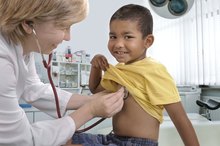Normal Triglyceride Levels for Children
Growing rates of obesity, physical inactivity and unhealthy eating among children continues to be a major problem in the United States. In fact, the American Heart Association notes that current rates of overweight and obese children and adolescents have tripled in the last 50 years 15. It should come as no surprise, then, that some children have begun to develop chronic health conditions -- like high triglyceride levels -- much earlier than expected. Identifying normal triglyceride levels is crucial for parents who want to ensure the health and longevity of their children.
If you are experiencing serious medical symptoms, seek emergency treatment immediately.
Triglyceride Basics
Triglycerides are a type of fat found in blood plasma. While a portion of total triglyceride stores are naturally produced by your child's body, others come from dietary sources -- such as carbohydrates. Calories not immediately used as fuel by your child's body may be converted to triglycerides and stored in fat cells in the blood stream, notes the American Heart Association 15. These stored triglycerides may be released by fat cells for energy during physical activity and between meals.
- Triglycerides are a type of fat found in blood plasma.
- These stored triglycerides may be released by fat cells for energy during physical activity and between meals.
Normal Child Triglyceride Levels
Normal Level of Cholesterol for Children
Learn More
The American College of Sports Medicine reports that normal triglyceride levels for children under the age of 18 are less than 150 mg/dL.
Causes of High Triglyceride Levels
The University of Rochester Medical Center notes that obesity and the consumption of significant amounts of fat, alcohol and sweets may also lead to this condition. In some cases, children with a strong family history may develop high triglyceride levels at an early age.
Treatment for High Triglycerides
How to Lower Children's High Triglyceride Levels
Learn More
Lifestyle modification is crucial for children who have been diagnosed with abnormal triglyceride levels. The American Council on Exercise reports that children who have abnormal triglyceride levels should be encouraged to start a regular exercise program that includes 60 minutes of aerobic exercise each day 4. Reducing caloric intake, lowering saturated fat consumption, and incorporating a colorful blend of various fruits and vegetables is essential for children who want to achieve normal triglyceride levels. Children who use tobacco or alcohol should stop immediately to keep triglyceride levels in check.
- Lifestyle modification is crucial for children who have been diagnosed with abnormal triglyceride levels.
- The American Council on Exercise reports that children who have abnormal triglyceride levels should be encouraged to start a regular exercise program that includes 60 minutes of aerobic exercise each day 4.
Related Articles
References
- American Heart Association: Triglycerides
- ACSM's Resource Manual for Exercise Testing and Prescription; American College of Sports Medicine
- University of Rochester Medical Center: Cholesterol, LDL, HDL, and Triglycerides in Children and Adolescents
- ACE's Personal Trainer Manual; American Council on Exercise
- American Heart Association: Overweight in Children
- Ballantyne CM, Grundy SM, Oberman A, et al. Hyperlipidemia: diagnostic and therapeutic perspectives. J Clin Endocrinol Metab 2000; 85:2089. DOI:10.1210/jcem.85.6.6642-1
- Austin MA, McKnight B, Edwards KL, et al. Cardiovascular disease mortality in familial forms of hypertriglyceridemia: A 20-year prospective study. Circulation 2000; 101:2777. DOI:10.1161/01.cir.101.24.2777
- Marston NA, Giugliano RP, Im K, et al. Association Between Triglyceride Lowering and Reduction of Cardiovascular Risk Across Multiple Lipid-Lowering Therapeutic Classes: A Systematic Review and Meta-Regression Analysis of Randomized Controlled Trials. Circulation 2019; 140:1308. DOI:10.1161/CIRCULATIONAHA.119.041998
- Durrington PN, Bhatnagar D, Mackness MI, et al. An omega-3 polyunsaturated fatty acid concentrate administered for one year decreased triglycerides in simvastatin treated patients with coronary heart disease and persisting hypertriglyceridaemia. Heart 2001; 85:544. DOI:10.1136/heart.85.5.544
- Third report of the National Cholesterol Education Program (NCEP) Expert Panel On Detection, Evaluation, And Treatment Of High Blood Cholesterol In Adults (Adult Treatment Panel III): Final report. US Department of Health and Human Services; Public Health Service; National Institutes of Health; National Heart, Lung, and Blood Institute. Circulation 2002; 106:3143.
Writer Bio
Kathryn Vera holds a master's degree in exercise physiology, as well as licensure as a Registered Dietitian. Currently, she works as a Clinical Exercise Physiologist in Cardiac Rehabilitation, where she provides care to patients living with chronic heart disease.









